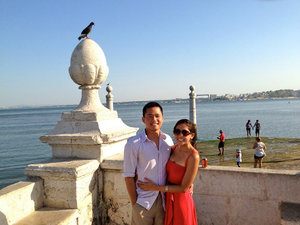Advertisement
Published: June 11th 2014

 Praca do Comercio
Praca do Comercio
Western-most part of the city, located on the Atlantic Ocean.Lisbon may not have the allure of Paris for romantics, Milan for fashionistas, or Vienna for musicians, but it's the oldest city in western Europe and that alone warrants attention from any traveler. Our decision to visit this city on the sea was somewhat accidental. Kristina was on a 3-week mission trip to Ghana and we didn't want to waste her long trek across the Pond, so I chose to meet her in Europe and make a vacation of it. Unfortunately, July is peak season for tourism on this continent, which entails high prices. To cut costs, we looked for the cheapest city to fly into Europe and behold, Lisbon was the answer. Little did we know this would prove to be an excellent choice.
My 10-hour flight across the lake found me at a pitstop in Azores, a picturesque island off the mainland that we hope to revisit one day when we return to this country. Once we arrived in town, we took a 15-minute cab ride from the airport for 15 euros (includes 3 bags of luggage) into the city center. Our hotel in Bairro Alto (the chic and hip area of Lisbon) was centrally located because this
part of town boasts a myriad of cute boutique shops, big name chain stores, hole-in-the-wall cafes and restaurants, mom-and-pop grocery stores, and everything your heart desires. If you like window shopping, walk along Rua Garret, the Lisbon equivalent of Fifth Avenue in Manhattan but with Old World Charm and loads of character that high-end designers haven't managed to infect...yet. While on this street, make sure to get some pasteis da nata (egg tarts), a delicious pastry mix of creamy and sweet. Continue eastward to Rua do Carmo where an elevator called Elevador do Santo Junta provides a magnificent view of the city, for a small fee, of course. Some say you can gain free access to this elevator from the west end on Rua do Carmo, but we failed to locate this entrance. Walk north on Rua 1 do Dezembro to Avenida da Liberdade, leading you to Placa dos Restauradores where you can enjoy the beautiful architecture that surrounds this plaza. Then walk southward down Avenida da Liberdade to Rossio Square and Praca Figueira adjacent to it, a space lined by buildings that personify European flare and exudes history.
Continue south into Baixa/Chiado (the downtown area) by going down
Rua da Prata, a cobblestone road where you can practically hear the horse-drawn carriages of centuries past. Here, you will find plenty of small cafes, shops, and tons of pedestrians, giving you a glimpse of how simple life in Portugal is. Next to this street is Rua Augusta, a slightly bigger and more touristy road blocked off to car traffic, allowing you to walk at a leisurely pace. This leads you to the emblem of the city, the Arca Triunfal (similar to Paris' Arc de Triomphe), which provides a fitting entrance into the most popular plaza in the city, Praca do Comercio. This is a vast space where locals gather for events, markets, festivals, etc., but for tourists like us, it's simply a great venue for people watching by the sea and soaking in the sun.
At night, you can head north along Rua San Pedro do Alcantara to an overlook called Miradouro do Alcantara. If you haven't noticed by this point, you will soon, but Lisbon--like many European cities--has countless overlooks and plazas throughout town for enjoying the view. This overlook in particular offers an awesome look at Castelo do Sao Jorge (a castle on top of the
hill), especially at night when the base of the castle is illuminated by lights. End the night with a hearty meal at the many restaurants around this area, most at a very reasonable price due to the ailing economy, particularly in Portugal. By this point, you've only experienced a fraction of Lisbon, so call it a night and get ready for Day 2 in the City of 7 Hills.
Advertisement
Tot: 0.364s; Tpl: 0.011s; cc: 9; qc: 58; dbt: 0.0684s; 1; m:domysql w:travelblog (10.17.0.13); sld: 1;
; mem: 1.1mb






